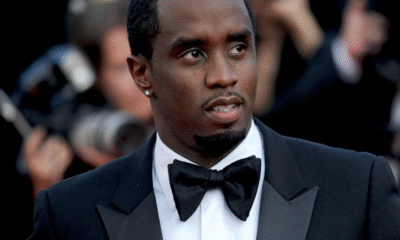Entertainment
Jenelle Evans Returns to OnlyFans Amid Latest Family Crisis; Fans Accuse Teen Mom Star of … on November 8, 2023 at 3:52 pm The Hollywood Gossip

Jenelle Evans is in the midst of several personal and legal crises that could result in major consequences and permanently alter the course of her life.
Jenelle is at the center of another CPS investigation after once again losing custody of her eldest son Jace.
And Jace’s allegations of abuse have already led to criminal charges for Evans’ husband, David Eason.
In a time of turmoil like this, most parents would set aside distractions and focus on creating a safe and stable environment for their children.
Jenelle Evans and David Eason have had a very rocky relationship. They remain committed to each other, though. (Instagram)
But not Jenelle and David.
No, these two are still hard at work promoting their new “careers.”
Eason is focused on becoming a rapper, while Evans has returned to the only business venture of her post-MTV life that has actually brought in some income.
Yes, Jenelle is back on OnlyFans, and she’s working overtime to promote her new content.
Jenelle Evans reclines on a bed and sports a red wig in an ad for her OnlyFans page. (Instagram)
Evans posted the photo above on her Instagram and Twitter pages on Tuesday.
“NEW content posted, NEW sent to DMs, and more scheduled tonight,” she captioned the post.
We don’t know if the ad has earned Jenelle any money, but it’s certainly attracted plenty of attention.
“She’s fucking dead in the eyes. It’s unsettling,” wrote a Reddit user who reposted the pic.
David Eason and Jenelle Eason attend the Cosmopolitan NYFW fashion show during New York Fashion Week at Tribeca 360 on February 08, 2019 in New York City. (Getty )
“Drugs. Just…. Drugs,” another user commented, adding:
“If I was in her situation I’d want to be high too. But she put herself there and it’s her job in life to be responsible for her children’s wellbeing.
“I can’t imagine the things those kids are going to be saying as they get older.”
Jenelle Evans and David Eason have cute kids. But their marriage doesn’t seem utopian. (Photo Credit: Instagram)
Other users suggested that Jenelle might be suffering from the effects of prolonged trauma.
“She has major trauma. But she’s now putting her kids through that same trauma. It’s terrible,” wrote one user.
“You have to remember it’s hard to break that cycle. Abusers will rip you apart … For the sake if the children I hope she wakes up soon,” another added.
Speaking of Jenelle’s kids, many are now convinced that the two who still live with her — son Kaiser and daughter Ensley (stepdaughter Maryssa is rumored to have been removed from the home) — are no longer attending school.
Jenelle Evans poses for an outdoor photo with daughter Ensley and son Kaiser. (Instagram)
Jenelle occasionally posts live content featuring her youngest kids in the middle of the day on weekdays.
And her supporters brush off the concern by insisting that Evans is homeschooling Kaiser and Ensley for the sake of their safety.
“I’m so glad Ensley is home learning important life skills like how to apply makeup instead of in school learning unimportant things like how to read or do math,” one commenter wrote in response to an Instagram Story that showed Jenelle and Ensley applying makeup.
“Still can’t get over that she took the kids out of school,” another added.
Jenelle Evans attends New York Fashion Week: The Shows at Industria Studios on February 7, 2019 in New York City. (Getty)
A third user speculated that Evans removed the kids from school so that they wouldn’t be questioned by CPS.
“JE hates spending time with her kids. She is probably pissed that they “had to” remove them from school to hide from CPS,” this person wrote.
It might be a while before we find out for sure what’s happening on The Land.
But sadly, it seems that this situation is likely to get worse before it gets better.
Jenelle Evans Returns to OnlyFans Amid Latest Family Crisis; Fans Accuse Teen Mom Star of … was originally published on The Hollywood Gossip.
Jenelle Evans is in the midst of several personal and legal crises that could result in major consequences and permanently …
Jenelle Evans Returns to OnlyFans Amid Latest Family Crisis; Fans Accuse Teen Mom Star of … was originally published on The Hollywood Gossip.
The Hollywood Gossip Read More
Entertainment
Hollywood’s Kiss or Miss Policy: Why Saying No Got Neal McDonough Blackballed

Neal McDonough’s name is synonymous with versatility on screen — from gripping war dramas like Band of Brothers to contemporary hits like Yellowstone. Yet behind his steady career lies a lesser-known story, one that exposes Hollywood’s surprising intolerance for personal conviction. McDonough’s insistence on a no-kissing rule in his contracts, a commitment driven by loyalty to his wife and family, resulted in a devastating blacklist that nearly cost him everything.

Holding Fast to His Values
Married since 2003 to model Ruvé Robertson and a devoted father to five children, McDonough chose not to compromise on his core beliefs, even at professional cost. Rather than chase fame at any price, he set a clear boundary that he would not share on-screen kisses with any woman other than his wife.
“I always had it in my contracts: no kissing other women on-screen,” McDonough explained. “I knew what it meant for my family, for my relationship, and I wasn’t going to step over that line.”
This deeply personal stance wasn’t born out of ego or sanctimony but a desire to protect the sanctity of his marriage and the wellbeing of his family.
“My wife is my priority,” he said. “The rest can wait.”
The Cold Shoulder from Tinseltown
What followed wasn’t the Hollywood applause McDonough might have hoped for, but instead a professional exile. Industry gatekeepers reportedly rejected him from roles and even dropped him mid-production over his refusal to perform intimate scenes that contravened his no-kissing policy.
“Hollywood turned on me hard and fast,” McDonough shared candidly. “I lost everything — the work, the goodwill, my sense of self.”
Reports surfaced of McDonough being pulled from a show Scoundrels just days into filming because he declined a kissing scene. The implication was clear: in Hollywood, kissing other women wasn’t a mere acting choice; it was a mandatory rite of passage.
Courage in the Face of Pressure
Neal McDonough’s story is an uncommon example of a man standing his ground in an industry built on appearances and compromises. His ordeal lays bare Hollywood’s tendency to steamroll personal boundaries in favor of “business as usual.”
“Intimacy is sacred to me,” McDonough said. “When I drew the line, it wasn’t popular, but it was necessary for who I am.”
His wife, Ruvé Robertson, who has stood beside him throughout, expressed unwavering support for his decision.
“Neal’s integrity is why our family stays strong. It’s more important than any role, any accolade,” she said.
A Journey Back to the Spotlight
After enduring years of silence and struggle, McDonough found his footing again through key allies in the industry who respected his boundaries and talent. Notably, in the film The Last Rodeo(2025), he broke his no-kissing rule — but only with his wife playing his on-screen partner.
“That kiss wasn’t just performance; it was a celebration of loyalty,” he reflected. “I had to have my wife by my side for it to feel right.”
The Bigger Picture
Neal McDonough’s journey challenges Hollywood to rethink its rigid expectations of actors and respect individual values. It’s a compelling story of fidelity and courage in an industry that often demands conformity at all costs.
“I hope my story encourages others to hold firm to who they are,” McDonough said. “Because no role should cost you your integrity.”
Entertainment
Ariana Grande’s Red Carpet: When Fans Forget Boundaries

At the Singapore premiere of the highly anticipated film “Wicked: For Good,” Ariana Grande faced an unsettling moment that quickly went viral. As the pop star confidently walked the yellow carpet alongside her co-stars, an overzealous fan, identified as 26-year-old Johnson Wen, broke through security barricades and lunged at her, grabbing her in an unexpected and alarming manner. The incident was swiftly halted thanks to the quick intervention of Ariana’s co-star Cynthia Erivo, who shielded the singer until security subdued the intruder.

Known online as “Pyjama Man,” Wen has a notorious reputation for crashing high-profile events to gain viral attention. This was not his first stunt; he had previously disrupted performances by stars like Katy Perry and The Weeknd. Following the incident, Wen posted footage of himself on Instagram, captioning it,
“Dear Ariana Grande, Thank You for letting me Jump on the Yellow Carpet with You,” much to the dismay of fans who criticized his reckless behavior.
The event has sparked widespread discussions about the safety and boundaries of celebrities attending public events. Ariana Grande, who has openly struggled with anxiety and trauma following the 2017 Manchester bombing, was visibly shaken but remained composed in the aftermath. Although she did not comment directly on the incident, she expressed gratitude to her fans in Singapore through social media posts.
Billie Eilish, another major music star, was also present and later reflected on how moments like these highlight the growing challenges celebrities face as fans blur the lines between admiration and invasion of privacy.

The incident at the “Wicked: For Good” premiere is a stark reminder that while celebrity fandom can be passionate, it must respect personal boundaries, especially in high-security environments intended to protect performers. Ariana Grande’s grace under pressure and activists like Cynthia Erivo’s immediate response prevented what could have been a far more serious encounter. Still, it raises serious questions about event security and fan etiquette in today’s hyper-connected celebrity culture.
This moment underscores a larger trend where stars find themselves navigating the precarious balance of engaging with fans while maintaining their safety and dignity on the public stage.
Entertainment
Wendy Williams Cleared of Dementia, Battles to End Guardianship

Wendy Williams, the well-known television personality, was long believed to be suffering from frontotemporal dementia (FTD), a diagnosis that led to her being placed under a court-ordered guardianship since 2022. However, recent medical evaluations by a top neurologist in New York have concluded that Wendy Williams does not have this degenerative condition. This groundbreaking revelation directly contradicts earlier diagnoses that justified strict legal control over her personal and financial decisions.

The original diagnosis had been used by her court-appointed guardian to limit Williams’ autonomy and isolate her from family and career opportunities. Friends, family, and legal representatives now assert that Wendy has remained mentally sharp, articulate, and physically recovered, challenging the notion that she is incapacitated. The new neurological tests showed no signs of the cognitive decline typically associated with frontotemporal dementia, which is known to be irreversible and progressive.
As a result of these findings, Wendy Williams’ lawyers are preparing to file documents to the court to terminate the restrictive guardianship arrangement. If the judge resists, her attorney plans to take the case to a jury trial, seeking to restore her full independence. This situation has brought to light concerns about guardianship abuse, misdiagnosis, and the potential misuse of legal powers, especially in high-profile cases.
The controversy surrounding her guardianship also involves allegations from her ex-husband, who earlier sued to end the guardianship, claiming it was harmful and exploitative rather than protective. His lawsuit described the guardianship as “a weapon, not a shield,” emphasizing the lack of therapeutic benefit for Wendy Williams.

This reversal of diagnosis is significant not only for Wendy Williams’ personal freedom but also for raising public awareness about the importance of accurate medical assessments before imposing such life-altering legal restrictions. Fans and advocates are hopeful that this development will mark the beginning of Wendy Williams’ return to public life on her own terms, free from unjust confinement.
In sum, Wendy Williams’ case highlights critical issues at the intersection of health, law, and individual rights, revealing how a flawed diagnosis can lead to profound consequences, including loss of autonomy and control over one’s life.

 News4 weeks ago
News4 weeks agoDiddy Wakes Up to Knife in Prison Attack

 Business4 weeks ago
Business4 weeks agoHarvard Grads Jobless? How AI & Ghost Jobs Broke Hiring

 Entertainment2 weeks ago
Entertainment2 weeks agoAfter Party: Festival Winner for Best Romantic Short

 News1 week ago
News1 week agoCamp Wackapoo – Rise of Glog Takes Center Stage

 Entertainment1 week ago
Entertainment1 week agoFrancisco Ramos Takes Top Mockumentary Award at Houston Comedy Film Festival

 Politics2 weeks ago
Politics2 weeks agoMamdani’s Victory Triggers Nationwide Concern Over New York’s Future

 Politics2 weeks ago
Politics2 weeks agoTrump’s $2,000 Tariff Dividend Plan: Who Gets Paid?

 News1 week ago
News1 week ago50-Year Mortgages: A Game Changer or a Debt Trap?



























